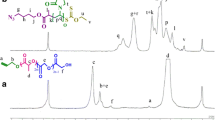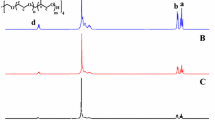Abstract
Effects of poly(ethylene glycol) (PEG) block length on the self-assembly of a series of pH-sensitive poly(N,N-diethylaminoethyl methacrylate)m-PEGn-poly(N,N-diethylaminoethyl methacrylate)m triblock copolymers (PDEAEMAm-PEGn-PDEAEMAm) have been studied. The synthesized triblock copolymers have an almost fixed PDEAEMA block length (m ≈ 65) and varying PEG block lengths (n = 11, 20, 89 or 134). The acid–base titration results show that the pKa value of the block copolymer shifts from 6.84 to 7.08 when the PEG block length increases from 11 to 134, indicating that the pH-sensitivity of the triblock copolymer can be adjusted through changing the PEG block length. With the increase of the hydrophilic PEG block length, the critical micelle concentration value of the triblock copolymer obtained from fluorescence spectroscopy changes from 5.50 × 10–3 to 13.23 × 10–3 mg mL−1. The block copolymers can self-assemble into the micelles in PBS solution at pH 7.4, and the average size of the self-assembly decreases from 178 nm to 45 nm with the increase of the PEG block length as determined by dynamic light scattering. The block copolymers show great biocompatibility in the cytotoxicity assay. Results from these triblock copolymers in the drug-controlled release indicate that the release rate of doxorubicin-loaded micelles at pH 5.0 is faster than that at pH 7.4, and the cumulative drug release in 48 h at pH 5.0 increases from 70.4% to 89.8% with the decrease of the PEG block length. Accordingly, this PDEAEMA65-PEGn-PDEAEMA65 copolymer is an excellent carrier for controllable drug delivery and release.







Similar content being viewed by others
References
Börner HG (2009) Strategies exploiting functions and self-assembly properties of bioconjugates for polymer and materials sciences. Prog Polym Sci 34(9):811–851. https://doi.org/10.1016/j.progpolymsci.2009.05.001
Tyrrell ZL, Shen YQ, Radosz M (2010) Fabrication of micellar nanoparticles for drug delivery through the self-assembly of block copolymers. Prog Polym Sci 35(9):1128–1143. https://doi.org/10.1016/j.progpolymsci.2010.06.003
Auriemma F, De Rosa C, Malafronte A, Di Girolamo R, Santillo C, Gerelli Y, Fragneto G, Barker R, Pavone V, Magilo O, Lombardi A (2017) Nano-in-Nano Approach for Enzyme Immobilization Based on Block Copolymers. ACS Appl Mater Interfaces 9(34):29318–29327. https://doi.org/10.1021/acsami.7b08959
Yang CX, Gao S, Dagnaes-Hansen F, Jakobsen M, Kjems J (2017) Impact of PEG Chain Length on the Physical Properties and Bioactivity of PEGylated Chitosan/siRNA Nanoparticles in Vitro and in Vivo. ACS Appl Mater Interfaces 9(14):12203–12216. https://doi.org/10.1021/acsami.6b16556
Tao YY, Zhao HY (2017) Synthesis and self-assembly of amphiphilic tadpole-shaped block copolymer with disulfides at the junction points between cyclic PEG and linear PS. Polymer 122:52–59. https://doi.org/10.1016/j.polymer.2017.06.046
Williford JM, Archang MM, Minn I, Ren Y, Wo M, Vandermark J, Fisher PB, Pomper MG, Mao HQ (2016) Critical Length of PEG Grafts on IPEI/DNA Nanoparticles for Efficient in Vivo Delivery. ACS Biomater Sci Eng 2(4):567–578. https://doi.org/10.1021/acsbiomaterials.5b00551
Cherng JY, Hou TY, Shih MF, Talsma H, Hennink WE (2013) Polyurethane-based drug delivery systems. Int J Pharm 450(1–2):145–162. https://doi.org/10.1016/j.ijpharm.2013.04.063
Ke F, Mo X, Yang R, Wang Y, Liang D (2009) Association of block copolymer in nonselective solvent. Macromolecules 42(14):5339–5344. https://doi.org/10.1021/ma900740b
Niu LY, Liu YY, Hou Y, Song WQ, Wang Y (2016) Self-assembly and micelle-to-vesicle transition from star triblock ABC copolymers based on a cyclodextrin core. Polym Chem 7(20):3406–3415. https://doi.org/10.1039/c6py00560h
Frisch H, Besenius P (2015) pH-switchable self-assembled materials. Macromol Rapid Commun 36(4):346–363. https://doi.org/10.1002/marc.201400623
Vuoriluoto M, Orelma H, Johansson LS, Zhu BL, Poutanen M, Walther A, Laine J, Rojas OJ (2015) Effect of Molecular Architecture of PDMAEMA-POEGMA Random and Block Copolymers on Their Adsorption on Regenerated and Anionic Nanocelluloses and Evidence of Interfacial Water Expulsion. J Phys Chem B 119(49):15275–15286. https://doi.org/10.1021/acs.jpcb.5b07628
Wang GY, Zhang LM (2016) Synthesis, self-assembly and pH sensitivity of PDEAEMA-PEG-PDEAEMA triblock copolymer micelles for drug delivery. React Funct Polym 107:1–10. https://doi.org/10.1016/j.reactfunctpolym.2016.08.001
Fabbri M, Soccio M, Costa M, Lotti N, Gazzano M, Siracusa V, Gamberini R, Rimini B, Munari A, Garcia-Fernandez L, Vazquez-Lasa B, San Roman J (2016) New fully bio-based PLLA triblock copoly(ester urethane)s as potential candidates for soft tissue engineering. Polym Degrad Stab 132:169–180. https://doi.org/10.1016/j.polymdegradstab.2016.02.024
Liu M, Leroux JC, Gauthier MA (2015) Conformation-function relationships for the comb-shaped polymer pOEGMA. Prog Polym Sci 48:111–121. https://doi.org/10.1016/j.progpolymsci.2015.03.001
Boudier A, Aubert-Pouessel A, Gerardin C, Devoisselle JM, Begu S (2009) pH-sensitive double-hydrophilic block copolymer micelles for biological applications. Int J Pharm 379(2):212–217. https://doi.org/10.1016/j.ijpharm.2009.05.032
Cai HH, Jiang GL, Shen ZH, Fan XH (2013) Solvent-induced hierarchical self-assembly of amphiphilic PEG(G(m))-b-PS dendritic-linear block copolymers. Soft Matter 9(m47):11398–11404. https://doi.org/10.1039/c3sm52439f
Phan H, Minut RI, McCrorie P, Vasey C, Larder RR, Krumins E, Marlow M, Rahman R, Alexander C, Taresco V, Pearce AK (2019) Role of self-assembly conditions and amphiphilic balance on nanoparticle formation of PEG-PDLLA copolymers in aqueous environments. J Polym Sci Pol Chem 57(17):1801–1810. https://doi.org/10.1002/pola.29451
Gil E, Hudson S (2004) Stimuli-reponsive polymers and their bioconjugates. Prog Polym Sci 29(12):1173–1222. https://doi.org/10.1016/j.progpolymsci.2004.08.003
Schmaljohann D (2006) Thermo- and pH-responsive polymers in drug delivery. Adv Drug Deliv Rev 58(15):1655–1670. https://doi.org/10.1016/j.addr.2006.09.020
Laskar P, Dey J, Ghosh S (2016) Evaluation of zwitterionic polymersomes spontaneously formed by pH-sensitive and biocompatible PEG based random copolymers as drug delivery systems. Colloids Surf B 139:107–116. https://doi.org/10.1016/j.colsurfb.2015.11.042
Oh KT, Kim D, You HH, Ahn YS, Lee ES (2009) pH-sensitive properties of surface charge-switched multifunctional polymeric micelle. Int J Pharm 376(1–2):134–140. https://doi.org/10.1016/j.ijpharm.2009.04.021
Manzanares-Guevara LA, Licea-Claverie A, Paraguay-Delgado F (2018) Preparation of stimuli-responsive nanogels based on poly(N, N-diethylaminoethyl methacrylate) by a simple “surfactant-free” methodology. Soft Mater 16(1):37–50. https://doi.org/10.1080/1539445x.2017.1391845
Farah S, Aviv O, Laout N, Ratner S, Beyth N, Domb AJ (2015) Quaternary ammonium poly(diethylaminoethyl methacrylate) possessing antimicrobial activity. Colloid Surface B 128:608–613. https://doi.org/10.1016/j.colsurfb.2015.01.051
Park JS, Lim YB, Kwon YM, Jeong B, Choi YH, Kim SW (1999) Liposome fusion induced by pH-sensitive copolymer: Poly(4-vinylpyridine-co-N, N '-diethylaminoethyl methacrylate). J Polym Sci Pol Chem 37(14):2305–2309. https://doi.org/10.1002/(Sici)1099-0518(19990715)37:14<2305::Aid-Pola3>3.3.Co;2-X
Tian W, Lv XY, Huang LB, Ali N, Kong J (2012) Multiresponsive Properties of Triple-Shell Architectures with Poly(N, N-diethylaminoethyl methacrylate), Poly(N-vinylcaprolactam), and Poly(N, N-dimethylaminoethyl methacrylate) as Building Blocks. Macromol Chem Phys 213(23):2450–2463. https://doi.org/10.1002/macp.201200283
Zhang Y, Ang CY, Li M, Tan SY, Qu Q, Luo Z, Zhao Y (2015) Polymer-Coated Hollow Mesoporous Silica Nanoparticles for Triple-Responsive Drug Delivery. ACS Appl Mater Interfaces 7(32):18179–18187. https://doi.org/10.1021/acsami.5b05893
Wu ZZ, Gan ZY, Chen B, Chen F, Cao J, Luo XL (2019) pH/redox dual-responsive amphiphilic zwitterionic polymers with a precisely controlled structure as anti-cancer drug carriers. Biomater Sci 7(8):3190–3203. https://doi.org/10.1039/c9bm00407f
Feng JJ, Wen WQ, Jia YG, Liu SL, Guo JW (2019) pH-Responsive Micelles Assembled by Three-Armed Degradable Block Copolymers with a Cholic Acid Core for Drug Controlled-Release. Polymers 11(3):511. https://doi.org/10.3390/polym11030511
Li S, Cai YY, Cao J, Cai MT, Chen YW, Luo XL (2017) Phosphorylcholine micelles decorated by hyaluronic acid for enhancing antitumor efficiency. Polym Chem 8(16):2472–2483. https://doi.org/10.1039/c6py02032a
Cortez-Lemus NA, Garcia-Soria SV, Paraguay-Delgado F, Licea-Claverie A (2017) Synthesis of gold nanoparticles using poly(ethyleneglycol)-b-poly(N, N-diethylaminoethylmethacrylate) as nanoreactors. Polym Bull 74(9):3527–3544. https://doi.org/10.1007/s00289-017-1906-5
Cohen N, Binyamin L, Levi-Kalisman Y, Berguig GY, Convertine A, Stayton P, Yerushalmi Rozen R (2016) pH and Salt Effects on Surface Activity and Self-Assembly of Copolymers Containing a Weak Polybase. Langmuir : the ACS journal of surfaces and colloids 32(36):9286–9292. https://doi.org/10.1021/acs.langmuir.6b02452
Adams DJ, Butler MF, Weaver AC (2006) Effect of block length, polydispersity, and salt concentration on PEO-PDEAMA block copolymer structures in dilute solution. Langmuir : the ACS journal of surfaces and colloids 22(10):4534–4540. https://doi.org/10.1021/la060192x
Li Y, Leng MT, Cai MT, Huang L, Chen YW, Luo XL (2017) pH responsive micelles based on copolymers mPEG-PCL-PDEA: The relationship between composition and properties. Colloid Surface B 154:397–407. https://doi.org/10.1016/j.colsurfb.2017.03.045
Tian M, Qin A, Ramireddy C, Webber SE, Munk P, Tuzar Z, Prochazka K (1993) Hybridization of block copolymer micelles. Langmuir : the ACS journal of surfaces and colloids 9(7):1741–1748. https://doi.org/10.1021/la00031a022
Maleki A, Zhu KZ, Pamies R, Schmidt RR, Kjoniksen AL, Karlsson G, Cifre JGH, de la Torre JG, Nystrom B (2011) Effect of polyethylene glycol (PEG) length on the association properties of temperature-sensitive amphiphilic triblock copolymers (PNIPAAM(m)-b-PEG(n)-b-PNIPAAM(m)) in aqueous solution. Soft Matter 7(18):8111–8119. https://doi.org/10.1039/c1sm05679d
Chen XR, Su Y, Shen F, Wan YH (2011) Antifouling ultrafiltration membranes made from PAN-b-PEG copolymers: Effect of copolymer composition and PEG chain length. J Membr Sci 384(1–2):44–51. https://doi.org/10.1016/j.memsci.2011.09.002
Ayen WY, Chintankumar B, Jain JP, Kumar N (2011) Effect of PEG chain length and hydrophilic weight fraction on polymersomes prepared from branched (PEG)(3)-PLA co-polymers. Polym Adv Technol 22(1):158–165. https://doi.org/10.1002/pat.1742
Wang JZ, del Rosario LS, Demirdirek B, Bae A, Uhrich KE (2009) Comparison of PEG chain length and density on amphiphilic macromolecular nanocarriers: Self-assembled and unimolecular micelles. Acta Biomater 5(3):883–892. https://doi.org/10.1016/j.actbio.2008.10.019
Matsumoto M, Takenaka M, Sawamoto M, Terashima T (2019) Self-assembly of amphiphilic block pendant polymers as microphase separation materials and folded flower micelles. Polym Chem 10(36):4954–4961. https://doi.org/10.1039/c9py01078e
Dong YM, Du PC, Pei ML, Liu P (2019) Design, postpolymerization conjugation and self-assembly of a di-block copolymer-based prodrug for tumor intracellular acid-triggered DOX release. J Mater Chem B 7(37):5640–5647. https://doi.org/10.1039/c9tb01511f
Verkoyen P, Johann T, Blankenburg J, Czysch C, Frey H (2018) Polymerization of long chain alkyl glycidyl ethers: a platform for micellar gels with tailor-made melting points. Polym Chem 9(44):5327–5338. https://doi.org/10.1039/c8py01312h
Zhang PY, Zhang ZH, Wang DL, Hao JC, Cui JW (2020) Monodispersity of Poly(ethylene glycol) Matters for Low-Fouling Coatings. ACS Macro Lett 9(10):1478–1482. https://doi.org/10.1021/acsmacrolett.0c00557
Wu B, Zhang L-J, Zhang C-J, Deng K, Ao Y-W, Mei H, Zhou W, Wang C-X, Yu H, Huang S-W (2020) Effect of Poly(ethylene glycol) (PEG) Surface Density on the Fate and Antitumor Efficacy of Redox-Sensitive Hybrid Nanoparticles. ACS Biomater Sci Eng 6(7):3975–3983. https://doi.org/10.1021/acsbiomaterials.0c00516
Miteva M, Kirkbride KC, Kilchrist KV, Werfel TA, Li H, Nelson CE, Gupta MK, Giorgio TD, Duvall CL (2015) Tuning PEGylation of mixed micelles to overcome intracellular and systemic siRNA delivery barriers. Biomaterials 38:97–107. https://doi.org/10.1016/j.biomaterials.2014.10.036
Jiang X, Li Y, Lu G, Huang X (2013) A novel poly(N-vinylcaprolactam)-based well-defined amphiphilic graft copolymer synthesized by successive RAFT and ATRP. Polym Chem-Uk 4(5):1402–1411. https://doi.org/10.1039/c2py20933k
Wu W, Zhang QJ, Wang JT, Chen M, Li S, Lin ZF, Li JS (2014) Tumor-targeted aggregation of pH-sensitive nanocarriers for enhanced retention and rapid intracellular drug release. Polym Chem-Uk 5:5668–5679. https://doi.org/10.1039/C4PY00575A
Wang K, Luo GF, Liu Y, Li C, Cheng SX, Zhuo RX, Zhang XZ (2012) Redox-sensitive shell cross-linked PEG–polypeptide hybrid micelles for controlled drug release. Polym Chem-Uk 3(4):1084–1090
Tian HY, Guo ZP, Lin L, Jiao ZX, Chen J, Gao SQ, Zhu XJ, Chen XS (2014) pH-responsive zwitterionic copolypeptides as charge conversional shielding system for gene carriers. J Control Release 174:117–125
Yang YQ, Zheng LS, Guo XD, Qian Y, Zhang LJ (2011) pH-sensitive micelles self-assembled from amphiphilic copolymer brush for delivery of poorly water-soluble drugs. Biomacromol 12(1):116–122
Acknowledgements
The authors are grateful for the support from Shanghai Branch, Du Pont China Co. Ltd. The authors wish to thank Prof. Dr. Hongli Zhao, Prof. Dr. Yun Ding and Prof. Dr. Aiguo Hu for their kindly assistance.
Author information
Authors and Affiliations
Corresponding author
Ethics declarations
Competing interests
The authors declare no competing financial interests.
Additional information
Publisher's Note
Springer Nature remains neutral with regard to jurisdictional claims in published maps and institutional affiliations.
Supplementary Information
Below is the link to the electronic supplementary material.
Rights and permissions
About this article
Cite this article
Zhang, L., Zhang, C., Gu, X. et al. Self-assembly, pH-responsibility and controlled release of doxorubicin of PDEAEMA-PEG-PDEAEMA triblock copolymers: effects of PEG length. J Polym Res 28, 175 (2021). https://doi.org/10.1007/s10965-021-02532-y
Received:
Accepted:
Published:
DOI: https://doi.org/10.1007/s10965-021-02532-y




